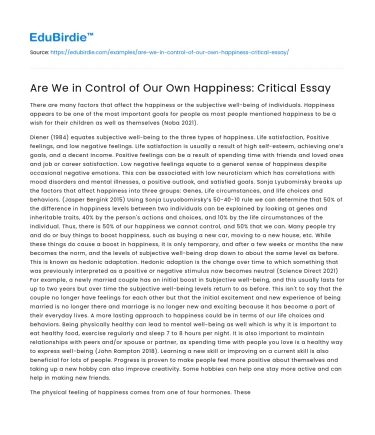There are many factors that affect the happiness or the subjective well-being of individuals. Happiness appears to be one of the most important goals for people as most people mentioned happiness to be a wish for their children as well as themselves (Noba 2021).
Diener (1984) equates subjective well-being to the three types of happiness. Life satisfaction, Positive feelings, and low negative feelings. Life satisfaction is usually a result of high self-esteem, achieving one’s goals, and a decent income. Positive feelings can be a result of spending time with friends and loved ones and job or career satisfaction. Low negative feelings equate to a general sense of happiness despite occasional negative emotions. This can be associated with low neuroticism which has correlations with mood disorders and mental illnesses, a positive outlook, and satisfied goals. Sonja Lyubomirsky breaks up the factors that affect happiness into three groups: Genes, Life circumstances, and life choices and behaviors. (Jasper Bergink 2015) Using Sonja Luyuobomirsky’s 50-40-10 rule we can determine that 50% of the difference in happiness levels between two individuals can be explained by looking at genes and inheritable traits, 40% by the person's actions and choices, and 10% by the life circumstances of the individual. Thus, there is 50% of our happiness we cannot control, and 50% that we can. Many people try and do or buy things to boost happiness, such as buying a new car, moving to a new house, etc. While these things do cause a boost in happiness, it is only temporary, and after a few weeks or months the new becomes the norm, and the levels of subjective well-being drop down to about the same level as before. This is known as hedonic adaptation. Hedonic adaption is the change over time to which something that was previously interpreted as a positive or negative stimulus now becomes neutral (Science Direct 2021) For example, a newly married couple has an initial boost in Subjective well-being, and this usually lasts for up to two years but over time the subjective well-being levels return to as before. This isn't to say that the couple no longer have feelings for each other but that the initial excitement and new experience of being married is no longer there and marriage is no longer new and exciting because it has become a part of their everyday lives. A more lasting approach to happiness could be in terms of our life choices and behaviors. Being physically healthy can lead to mental well-being as well which is why it is important to eat healthy food, exercise regularly and sleep 7 to 8 hours per night. It is also important to maintain relationships with peers and/or spouse or partner, as spending time with people you love is a healthy way to express well-being (John Rampton 2018). Learning a new skill or improving on a current skill is also beneficial for lots of people. Progress is proven to make people feel more positive about themselves and taking up a new hobby can also improve creativity. Some hobbies can help one stay more active and can help in making new friends.
Save your time!
We can take care of your essay
- Proper editing and formatting
- Free revision, title page, and bibliography
- Flexible prices and money-back guarantee
The physical feeling of happiness comes from one of four hormones. These are dopamine, serotonin, endorphins, and oxytocin. Each of these has specific roles in the type of happiness you get but they can all equate to the “feel good” sensation.
Dopamine is a neurotransmitter stored in the mid-brain which when released gives feelings of pleasure, reward or satisfaction, and motivation. Dopamine is a part of the reward system which is present in both humans and animals. The reward system aims to reward an individual when they are doing something that better their survival. For example, eating or exercising. So, when one is doing these things the brain releases dopamine as the reward. As humans, we seek to find more of what makes us feel good and this is the reason why many people develop addictions to cocaine, heroin, and even sugar. However, these addictions disturb the natural production of dopamine and set the reward system off balance.
Endorphins are produced by the hypothalamus and pituitary gland during exercise, laughter, sexual activity, and sometimes in food consumption. Endorphins give rise to a euphoric feeling and are often released after intense exercise. This feeling can be known as “runner high”
Serotonin is released all throughout the brain and central nervous system to give the feeling of well-being and general happiness. When serotonergic neurons are stimulated serotonin is released from vesicles into the synaptic cleft. The serotonin then binds to the postsynaptic neuron thus giving us the feeling of happiness. Errors or faults within this process are linked to depressive disorders.






 Stuck on your essay?
Stuck on your essay?

